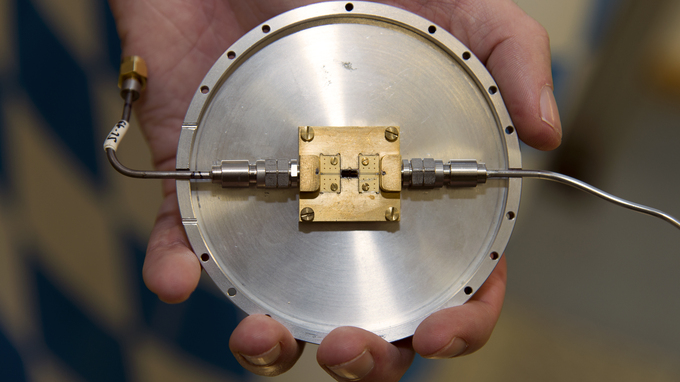Das Quanteninternet kommt in Reichweite
Abhörsichere Kommunikation zwischen Quantencomputern realisiert
2019-10-24 – Nachrichten aus dem Physik-Department

Noch gibt es weltweit keinen universellen Quantencomputer. Doch einem internationalen Team um die TUM-Physiker Rudolf Gross, Frank Deppe und Kirill Fedorov ist es nun erstmals gelungen, in einem lokalen Netzwerk eine abhörsichere Quantenkommunikation zu realisieren – über ein supraleitendes Kabel auf einer Distanz von 35 Zentimetern.
„Wir haben damit die Grundlage für die Realisierung von Quantenkommunikationssystemen im sehr wichtigen Mikrowellenbereich gelegt“, sagt Rudolf Gross, Professor für Technische Physik an der TU München und Direktor des Walther-Meißner-Instituts (WMI), an dem die Versuche stattfanden. „Dies ist ein Meilenstein. Damit ist das Quanteninternet auf Basis von supraleitenden Schaltungen und Mikrowellenkommunikation nun in Reichweite.“
Jahrelange Pionierarbeit
Die Forscher am WMI leisten seit mehr als einem Jahrzehnt Pionierarbeit auf dem Gebiet der Ausbreitung von Quanten-Mikrowellen. Dafür mussten sie zunächst nachweisen, dass Mikrowellenstrahlung überhaupt quantenmechanische Eigenschaften haben kann, was anders als bei sichtbarem Licht, aufgrund der geringen Energie der Mikrowellenphotonen technisch extrem herausfordernd war.
Um störende Einflüsse zu eliminieren, fanden die Experimente bei Temperaturen nahe dem absoluten Nullpunkt statt. In besonderen Kühlvorrichtungen gelang es den Physikern schließlich, im Mikrowellenbereich etwa das Prinzip der Verschränkung zu belegen, einer wichtigen Grundlage für sichere Quantenkommunikation.
Abhörsicheres Protokoll durch Verschränkung
Die aktuelle Arbeit bringt die Physiker nun der Anwendung einen Schritt näher: „Quantum Remote State Preparation“ nennen sie das Kommunikationsprotokoll. Dabei wird ein Quantenzustand an einem entfernt liegenden Ort hergestellt, ohne ihn direkt zu senden.
Anschaulich kann man sich das Konzept so vorstellen: Zwei Personen, nennen wir sie Anna und Bert, befinden sich an zwei verschiedenen Orten. Während in der klassischen Informatik das Bit die kleinste Informationseinheit ist, ist dies in der Quantenkommunikation ein Quantenzustand.
Möchte Anna nun Bert eine Information zukommen lassen, bekommen beide einen Teil eines verschränkten quantenmechanischen Zustands mitgeteilt. Anna führt dann zunächst eine Messung an ihrem Teil des Zustands aus und übermittelt das Ergebnis klassisch an Bert. Der vollzieht eine vom Ergebnis abhängige Operation an seinem Teil des verschränkten Zustands und erhält so den Quantenzustand, den Anna ihm mitteilen will.
Dritte können mit dem zwischendurch übermittelten klassischen Messergebnis allein nichts anfangen, sie bräuchten dazu den verschränkten Zustand. Eine Kommunikation mit diesem Protokoll ist daher absolut abhörsicher.
Informationsübertragung mit gequetschten Wellen

Als Quantenzustand nutzen die Forscher einen sogenannten gequetschten Mikrowellenzustand. Dabei handelt es sich um eine besondere Ausprägung einer elektromagnetischen Welle, die nur mit Hilfe der Quantenmechanik erklärt werden kann.
Vakuumfluktuationen einer Welle werden dabei in einer bestimmten Richtung unterdrückt und in der dazu senkrechten verstärkt. Aus zwei solchermaßen gequetschten Zuständen lässt sich ein verschränkter Mikrowellenzustand erzeugen. Die Technik dazu haben die Physiker ebenso wie andere wichtige Details, beispielsweise supraleitende Quantenschaltkreise, eigens am Walther-Meißner-Institut in Garching entwickelt.
Sieben Meter lange, gekühlte Quantenkabel
Das neue Konzept könnte eine revolutionäre Entwicklung auslösen. „Die experimentelle Realisierung einer sicheren Quantenkommunikation im Mikrowellenbereich ist ein wichtiger Schritt hin zum verteilten Quantenrechnen “, sagt Frank Deppe, am WMI-Koordinator des Europäischen Flaggschiff-Projekts Quantum Microwave Communication and Sensing (QMiCS).
Die TUM-Physiker halten auch deutlich größere Abstände zwischen Quantenrechnern für möglich. Eine Herausforderung stellt hier die Entwicklung und Vermessung mehrerer Meter langer, gekühlter Quantenkabel dar. „Wir arbeiten im Rahmen von QMiCS bereits an einer Erweiterung auf sieben Meter Entfernung“, sagt Gross. „Damit rückt die Vernetzung von supraleitenden Quantenrechnern in Reichweite.“
Veröffentlichung
Weitere Informationen
Die Arbeiten wurden gefördert durch die Deutsche Forschungsgemeinschaft (DFG), durch den Exzellenzcluster „Munich Center for Quantum Science and Technology“ (MCQST), das Doktorandenprogramm ExQM des Elite-Netzwerks von Bayern, durch die Europäische Union im Rahmen des Flagship-Projekts QMiCS und durch spanische und japanische Förderprogramme. Das Walter-Meißner-Institut für Tieftemperaturphysik ist eine Einrichtung der Bayerischen Akademie der Wissenschaften (BAdW).
Verwandte Meldungen
- Licht in der Nanowelt – 2019-08-01
- Vortrag „Quantentechnologie: 100 Millionen € für Garching“ – 2019-07-02
- Kühlung für Quantenelektronik – 2019-06-12
- TUM mit vier Exzellenzclustern erfolgreich – 2018-09-27
- Zentrum für Quantentechnik kommt nach Garching – 2018-04-30
- Microwaves slowed down to pedestrian speeds – 2013-02-01
